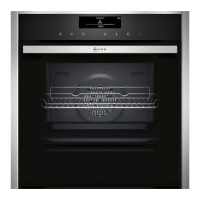How it works en
43
24.8 Special cooking methods and other
applications
Information and recommended settings for special
cooking methods and other applications, e.g. slow
cooking or preserving.
Slow cooking
Cook prime cuts of meat slowly at a low temperature,
e.g. tender cuts of beef, veal, lamb or poultry.
Low temperature cooking poultry or meat
Note:When using the low temperature cooking type of
heating, you cannot delay the start of the programme
by setting an end time.
Requirement:The cooking compartment is cold.
1.
Use fresh, clean, hygienic meat without bones.
2.
Place the cookware onto the wire rack at level 2 in
the cooking compartment.
3.
Preheat the cooking compartment and cookware for
approx. 15minutes.
4.
Sear the meat on all sides on the hob at a very high
heat.
5.
Immediately place the meat into the pre-warmed
cookware in the cooking compartment.
To ensure that the climate in the cooking compart-
ment remains constant, keep the cooking compart-
ment door closed during low temperature cooking.
6.
After low temperature cooking, remove the meat
from the cooking compartment.
Recommended settings for slow cooking
Food Accessory/cook-
ware
Shelf pos-
ition
Searing
time in
mins
Heating function
→Page7
Temperature
in °C
Cooking
time in
mins
Duck breast, medium
rare, 300g each
Uncovered cook-
ware
2 6 - 8 90
1
45 - 60
Fillet of pork, whole Uncovered cook-
ware
2 4 - 6 80
1
45 - 70
Fillet of beef, 1kg Uncovered cook-
ware
2 4 - 6 80
1
90 - 120
Veal medallions, 4cm
thick
Uncovered cook-
ware
2 4 80
1
30 - 50
Saddle of lamb, bone-
less, 200g each
Uncovered cook-
ware
2 4 80
1
30 - 45
1
Preheat the appliance.
Sous-vide
Sous-vide cooking is a method of cooking in a vacuum
at low temperatures between 50 and 95C and in
100% steam.
Sous-vide cooking is a gentle method of cooking meat,
fish, vegetables and desserts.
A chamber vacuum-sealing machine is used to heat-
seal the food in a special air-tight, heat-resistant va-
cuum-sealing bag.
The protective envelope of the vacuum-sealing bag re-
tains the nutrients and flavours. The low temperatures
and the direct transfer of heat allow precisely controlled
cooking in order to achieve the desired cooking res-
ults. It is almost impossible to overcook the food.
Sous-vide cooking tips
¡ Servings
– Take into consideration the specified quantities
and sizes for the food listed in the recommended
settings tables. Adjust the cooking time for larger
quantities and items.
– The appliance can cook up to 2kg of food sous-
vide.
– The quantities given for fish, meat and poultry
correspond to one to two servings.
– For vegetables and desserts, the specified quant-
ity is for 4people.
¡ You can cook on up to two levels. When you do
this, always slide the universal pan in at level1 to
catch any drops of condensate. Insert the wire racks
at the levels above accordingly.
¡ The quality of the cooking result is 100% influenced
by the quality of the ingredients you use. Use only
fresh, top-quality food. This is the only way to guar-
antee a consistent cooking result that delivers im-
peccable flavour.
Vacuum-sealing food
To ensure an even transfer of heat and an optimised
cooking result, use a chamber vacuum-sealing ma-
chine that can create a 99% vacuum when vacuum-
sealing food.
Tip:To prevent gases escaping from the food, e.g.
from vegetables, vacuum-seal the food no more than
one day before you cook it. The gases inhibit the trans-
fer of heat or cause the texture of the food to change,
thus altering how it cooks, as a result of the vacuum
pressure.
Note:Do not use a core temperature probe.
1.
Season food with half the usual the amount of
spices.
Cooking in a vacuum means that the flavours can-
not escape. The usual quantities of flavourings such
as spices, herbs and garlic affect the taste much
more and intensify it.
Tip:You can intensify the natural flavours of high-
quality food simply by adding a small knob of butter
and a little salt to the vacuum-sealing bag.
Different ingredients affect how the food cooks:
– Salt and sugar reduce the cooking time.

